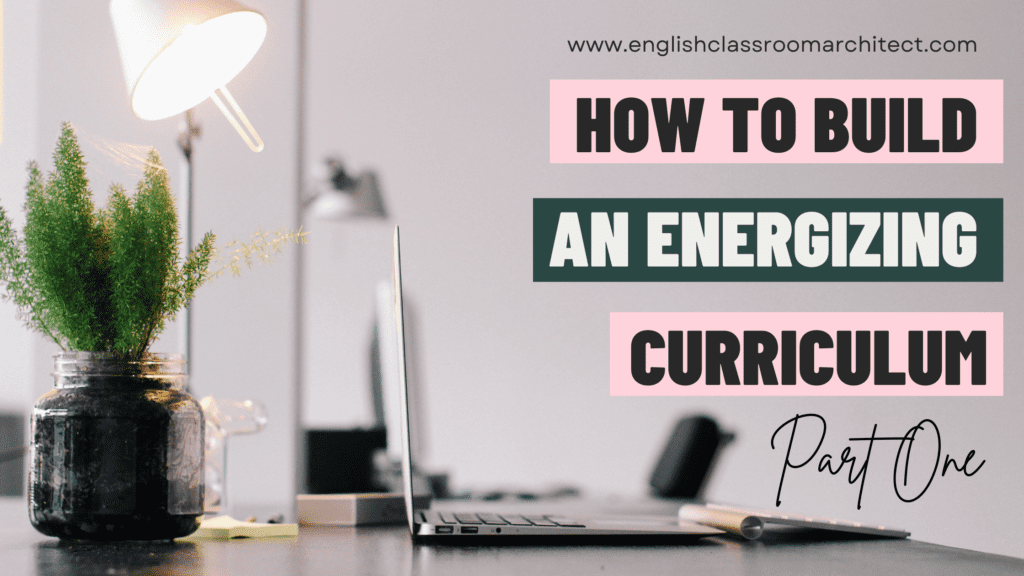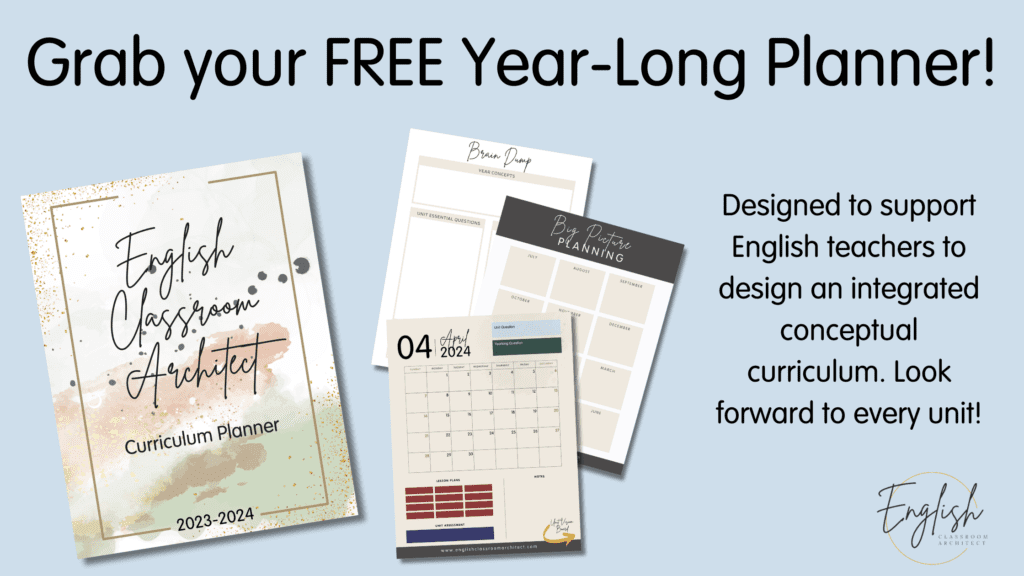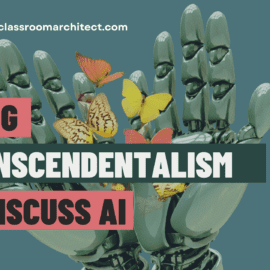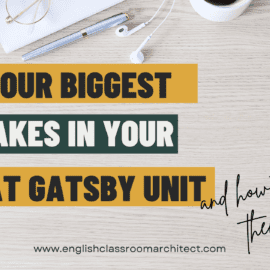As high school English teachers, we face a multitude of challenges in today’s educational landscape. From dwindling reading habits to the need for practical learning, it is crucial for us to adapt our approaches and make our curricula more engaging and relevant. Curriculum planning is a powerful tool to address these challenges. Being thoughtful and intentional as we build curriculum is one of our greatest keys to a teaching life that is efficient and fulfilling.
Table of Contents

What is a Curriculum Plan? An Integrated Approach
What is a curriculum plan? I’ll start by talking about the possibilities. When teachers use an integrated curriculum, we think not just about the skills we want students to learn over the year, but we also consider what kinds of conversations we want our students to have during the year, and what topics we want them to be able to discuss with depth and complexity. Teaching with an integrated approach pushes us to think about a layered experience, with students gaining a better understanding of their world throughout the year, bolstered by literature and other media.
Planning with concepts in mind, we can build on the richness of our discipline. Contemporary English instruction includes literature, but it also includes forms of multimedia. We can explore the evolution of writing and the forms that it takes today. We can explore the intersection of canonical literature and YA literature, and the rise of more visual forms of written expression. We can look at the proliferation of self-publishing and how that has influenced our perception about writing and literature. We have video, podcasting, multimedia, and even social media under our umbrella. There is so much to explore.
By intentionally incorporating interrelated topics and various perspectives, we create a rich learning experience for our students. This approach fosters engagement, encourages critical thinking, and promotes a deeper understanding of the interconnectedness of knowledge.
Why Focus on Concepts?
Studies have suggested that there is a correlation between level of background knowledge and reading level. We can see this anecdotally. When teachers preload important background information we see students pick up on nuances of the text that they may not have understood otherwise.
Recently I changed my approach to how I teach The Great Gatsby. I’ve been frustrated about how students misunderstand Jay Gatsby and even in the end of the novel admire him and aspire to be him. This year I started the unit by having students complete a research project on Prohibition-Era gangsters to understand what it means that Jay Gatsby was associated with bootlegging and Meyer Wolfsheim. I found that with this change they picked up more on the nuances–Gatsby invite to Nick to engage in insider trading, the story Meyer Wolfsheim tells about the death of the real-life gangster Rosy Rosenthal, Meyer Wolfsheim’s protege, working as Gatsby’s doorman all led to discussion and connection where before they didn’t get this nuance. Understanding that Gatsby brushes off these details helps us better understand Gatsby and his readiness to engage in questionably ethical activities, which in turn encourages the reader to further question Nick as a reliable narrator. With this strengthened background information students read with greater detail and clarity.
The Purpose of Curriculum Planning – Reimagine Teaching and Empowering Students
Our goal as educators is not simply to transmit information, but to engage students in meaningful and relevant learning experiences. As English teachers, our breadth of content delivery is large. This is a blessing and a curse. We have opportunities to pursue texts, topics, and strategies that appeal to us and our students. We want to share everything that we find enjoyable about our content area. But because there is SO MUCH this can also lead to overwhelm and decision fatigue.
Through curriculum planning, we can create opportunities for students to explore real-world connections, think critically, and apply their knowledge in practical ways. By empowering our students to become active participants in their own learning, we foster their growth as lifelong learners.
Consider your own teaching. Do your units feel inspired? Do you have systems in place both for students and for yourself that help you be efficient in your planning, teaching, and grading? Do your students understand how the pieces of your curriculum fit together or do they think of them as disparate and disconnected?
Benefits for Teachers in Curriculum Planning with an Integrated Approach
The benefits of curriculum planning to students are clear, but there are also reasons why we should embrace it. For every novel we have a multitude of directions we can go in as we share our love with a piece of literature with students. But, if our goal is to build a layered conceptual experience for our students we have to be intentional about where we put our analytical focus throughout the year. Being clear on what we want to cover during the year, both in skill and content, is paramount to not feeling overstretched. Having this clarity allows us to be clear about what we are not doing during the year and allows for a more streamlined curriculum.
I have personally seen the benefits of being intentional in my own classroom and curriculum. I have been able to streamline my processes and workload so that I’m limiting my work (mostly) to a contract hour day. Even though I am working less I do not feel my students are getting less. In fact, I think they are getting more. With intentionality they have deeper understanding of content and I have more time in my curriculum for what I find fun and enjoyable, which leads to a happier teacher. Ironically, planning allows me to be more flexible, as I have a clear understanding of where I want my students to be at the end so I can confidently make adjustments through the year.
In my district, we have half day testing blocks when we get to state testing season. With intentional planning I have been able to use this time in ways that my students are actually engaged for the entire block. Well, okay. Most of the block. It’s a great system, but it’s not magic.
Having a clear plan means that I am not overloaded with grading at the end of a marking period because I have planned late work deadlines and assessments intentionally.
If this is not your reality, I will share tips and resources in the next parts of this series to help you get there.
The Process of Building an Integrated Curriculum
In the next part of this curriculum planning series I will walk you through a process of framing your curriculum with big questions and considering where you want your students to be at the end of the year. These big questions serve as a roadmap for crafting a well-structured and engaging curriculum. Thinking about the final assessment at the beginning helps us envision the ultimate goal and desired outcomes of our curriculum, ensuring our students’ learning is measurable and meaningful. This intentional and sequential process ensures our curriculum is coherent and rigorous.
In the third part of the series, we will take those big questions and use them to guide our use of texts and the concepts of our units. I will show you a strategy to incorporate texts, whether what you have at your disposal is limited and strict or abundant and flexible, and build your units. I will give you tips and resources for English unit plan ideas.
Conclusion
Curriculum planning is an essential tool for tackling the challenges we face as educators. By embracing an integrated approach and shifting our focus to conceptual understanding first, we can create transformative learning experiences for our students. In the next blog post of this series, we will delve into the three-step process to build the frame of our curriculum. Lets reimagine our teaching and empower our students to thrive in a dynamic and interconnected world.
Read the next post in the series!




